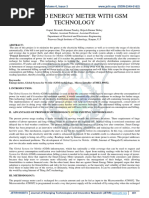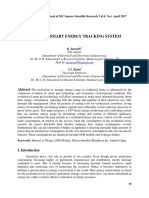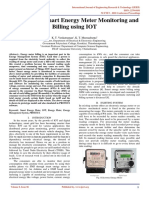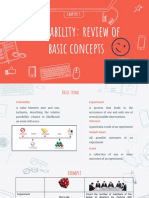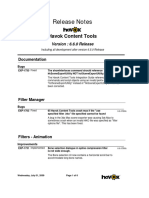16 Load NC
16 Load NC
Uploaded by
mayurbrathod2811Copyright:
Available Formats
16 Load NC
16 Load NC
Uploaded by
mayurbrathod2811Original Title
Copyright
Available Formats
Share this document
Did you find this document useful?
Is this content inappropriate?
Copyright:
Available Formats
16 Load NC
16 Load NC
Uploaded by
mayurbrathod2811Copyright:
Available Formats
International Journal of Advanced Research in Electrical, Electronics and Instrumentation Engineering (IJAREEIE)
| e-ISSN: 2278 – 8875, p-ISSN: 2320 – 3765| www.ijareeie.com | Impact Factor: 7.122|
|| Volume 9, Issue 6, June 2020 ||
Load Management Using GSM
Shilpa S.K1, Mallika N2, Pooja Kasala3, Taheer Ahamed⁴, Vishwanath N.V5
Assistant Professor, Department of Electrical and Electronics Engineering, BIET, Davanagere, Karnataka, India
UG Student, Department of Electrical and Electronics Engineering, BIET, Davanagere, Karnataka India2,3,4,5
ABSTRACT: Power shortage is a major issue in India. As the electric power generation does not satisfy the increasing
demand, power shortage occurs, which results in power outage. Presently, the power shortage is managed by supplying
power in one area by cutting off power in another area. This will cause a lot of inconvenience for the consumers who
are located in the power shutdown area. During summer, the problem would be still worse. We are proposing a solution
for this problem using GSM technology. In this proposed system we are reducing the power supply and also the system
is capable of monitoring various parameters of electrical energy like Voltage, Current, energy consumption in kWh,
cost based on tariff for the energy consumption, etc., and the consumer can take suitable precautions to safe guard and
financially plan the consumption of electrical appliances. The consumer can monitor the load during peak hours and
become an active part of Energy Management system. The consumers get benefited for limiting the consumption
during peak hours, they become vigilant in managing electricity consumption and hence their electricity bill. The
proposed system is useful to both utility provider and consumers as it manages energy consumption. The system can
take the consumers financial allocation for electricity bill as the input and monitors the load consumption. When the
load consumption reaches about 90% of the allotted budget limit, SMS alert is sent to the consumer Via GSM module.
Based on priority, the load is shut down for each room or connected load of the residence through relays. The user has
the decision to continue the energy consumption by communicating to the Module via SMS. The budget can be set by
the user each month, which would be notified to the user via SMS. If the budget is not reset to a new value, the previous
set value is taken as default.
KEYWORDS: GSM (Global system for mobile communication), LCD (Liquid crystal display), GUI (Graphic User
Interface), RTC (Real Time Clocks), PLC (Programmable Logic Control) SMS (Short Message Service).
I. INTRODUCTION
The Electricity is one of the most important requirements of modern civilization, without which various
indispensable applications will bind to bring to a standstill. It can be noticed that the demand for electricity is
increasing along with population and its dependency, thus increasing the power consumption. On Application of data
analytics to the gathered metering data, via energy meter, awareness of energy consumption is made viable and
development of new energy efficiency services. As per the report of CEA, India [23], the gap between the electrical
energy supply and the energy demand in July-2014 is -3.9% (MW). Accurate metering, detection of illegal activities
and implementation of proper tariff and billing system would manage the consumption of electrical energy.
With the current trend, the advancement in load priority and load management is steadily growing with
innovations such as a system that facilitates automatic recognition of switching events of electric appliance [9][16] that
applies data analytics to the gathered metering data allowing the system to raise energy awareness by providing better-
tailored energy feedback without the need for special purposed hardware. This can be extended to load monitoring in
which the system classifies the load based on consumption and records their operating period respectively using
signature recognition algorithm. Considering in a larger scale, the concept of load shedding [5][14] paved way for the
implementation of the same in automation of home appliances. The GUI (graphic User Interface) is used to notify the
user of the consumption which is basically load monitoring in a larger area via smart
grid [17]. The timings of individual areas are set by the user using Real time clocks (RTC) on GUI [17]. The GUI is
operated using PLC and SCADA, as it is easier for large data processing and operation. For small scale, in
consideration of residential or commercial buildings, the use of PLC (Programmable Logic Controller) and SCADA
(Supervisory Control and Data Acquisition) would not be economic. Hence mostly IOT based systems for automation.
With the replacement of analog Energy meters by digital meters, the transformation in the energy meter keeps evolving
with time. Hybrid and smart energy meters have come into existence [4][12]. With the use of Smart meters the
consumer can monitor various parameters of electrical supply and can take necessary precautions to improve power
quality and its consumption. The smart energy meter consists of anti- tampering and anti-theft measures that help in
billing process for the service providers.
IJAREEIE © 2020 | An ISO 9001:2008 Certified Journal | 1347
International Journal of Advanced Research in Electrical, Electronics and Instrumentation Engineering (IJAREEIE)
| e-ISSN: 2278 – 8875, p-ISSN: 2320 – 3765| www.ijareeie.com | Impact Factor: 7.122|
|| Volume 9, Issue 6, June 2020 ||
The proposed System is capable of monitoring various parameters of electrical energy like Voltage, Current, energy
consumption in kWh, cost based on tariff for the energy consumption, etc., and the consumer can take suitable
precautions to safe guard and financially plan the consumption of electrical appliances. The consumer can monitor the
load during peak hours and become an active part of Energy Management system. The consumers get benefited for
limiting the consumption during peak hours, they become vigilant in managing electricity consumption and hence their
electricity bill. The proposed system is useful to both utility provider and consumers as it manages energy consumption.
The system can take the consumers financial allocation for electricity bill as the input and monitors the load
consumption. When the load consumption reaches about 90% of the allotted budget limit, SMS alert is sent to the
consumer Via GSM module. Based on priority, the load is shut down for each room or connected load of the residence
through relays. The user has the decision to continue the energy consumption by communicating to the Module via
SMS. The budget can be set by the user each month, which would be notified to the user via SMS. If the budget is not
reset to a new value, the previous set value is taken as default.
II. PROBLEM STATEMENT
Power wastage is one of the issue in India. The main goal of the project is to decrease electricity wastage. So this
project proposing a solution for the problem using GSM technology. In this project, the power supply reduces to each
customer thus increasing the number of consumers. The consumer has to reduce the load in order to get electricity
gain.
III. OBJECTIVES AND SCOPE
Simplicity and cost-effective.
Smart load management system.
GSM technology is convenient and having fast communication.
To access the load in a safe condition even when the operator is far away from the load side.
IV. LITERATURE SURVEY
Paper 1.Leveraging smart meter data to recognize home appliances Weiss,M. Helfenstein, A. and Staake, T (2012).
In this paper a detailed description and evaluation of a system that facilitates automatic recognition of switching
events of electric appliances. This objective is achieved by interconnecting components that are becoming ubiquitous
in home environments: a smart meter and a smart phone. The signature database is established over time and allowing
new devices that is an integral part of fast changing home environment. Applying data analytics to the gathered
metering data allows the system to raise energy awareness by providing better-tailored energy feedback without the
need for special purposed hardware. In combination with actuation capabilities, we can foresee this information to be
used to automatically optimize energy consumption and hence increase residential energy efficiency. In this paper we
present an infrastructure and a set of algorithms that make use of smart meters together with smart phones to realize
new energy efficiency services (such as itemized electricity bills or targeted energy saving advice). The algorithm was
developed based on the data collected by individual appliances and their
energy consumption as training sets. The signature recognition i.e. the type of load and energy consumption was 87 %
with simultaneous connection of 8 loads. It classifies the load based on consumption, monitors and records their
operating periods respectively using signature recognition algorithm.
Paper 2. An Embedded Technology Based Automated City Load Shedding Management Scheme, Abhishek Pawar
, Zainab Mizwan (Vol. 6, Issue 10, October- 2018).
Load shedding strategy is applied when there is not enough electricity available to meet Load shedding strategy is
applied when there is not enough electricity available to meet the increasing demand of consumers, and an electricity
supply or utility company stops the energy supply to certain areas. It is a last option to balance Electricity supply and
demand. The process is more prone to hum an errors as an operator has to manually switch the load ON/OFF. In this
paper, an automated load shedding management module was developed and used to demonstrate the use of embedded
systems concept in the field of Power System Automation. By using low cost components and programmed ARM
processor automatic switching operations in various stages of the lab-scale model of the given circuit arrangement is
performed and available power is distributed with the automated load shedding plan. The scheme was automated, thus
eliminating human error completely. From the graphic user interface (GUI) the relays are turned ON or OFF based on
the load distribution. The GUI is also used to notify the user of the consumption. The timings of individual areas are set
by the user using Real time clocks (RTC) on GUI.
IJAREEIE © 2020 | An ISO 9001:2008 Certified Journal | 1348
International Journal of Advanced Research in Electrical, Electronics and Instrumentation Engineering (IJAREEIE)
| e-ISSN: 2278 – 8875, p-ISSN: 2320 – 3765| www.ijareeie.com | Impact Factor: 7.122|
|| Volume 9, Issue 6, June 2020 ||
V. METHODOLOGY
The system is built sequentially by simulation and coding with the help of Arduino IDE software. The program is
dumped to developing board (Arduino Mega) using USB
2.0 cable. By connecting a load (lamp load), the current is drawn through the sensor. On detection of current, the LCD
displays the current value. The power consumption displays in LCD is verify with that of the energy meter reading. The
keypad is connected to the Arduino board, it is used to set the budget as per consumer need. The Arduino board is
connected to the GSM module and it is programmed to send SMS alert to the registered number (Defined in the
program) when the load power consumption is reaches to 90 percent of the set value. Once the alert is notified, the load
is tripped for the first load which is set in load priority. The load priority list is set by the user to trip in sequential order,
so that if any important work or the necessity of power for the particular load is not alerted.
Fig: 1 Block diagram of the system
At the end of the month, another notification is sent to the user to reset the budget for the next month. If the budget
is not reset by the user, the previous value that is set by the user is taken for the next month.
VI. COMPONENTS USED
1. Arduino mega 2560
The Arduino Mega 2560 is a microcontroller board based on the ATmega2560.Purpose for using Arduino mega 2560
is where most pins comes in with 54 Digital I/O pins (were 15 of them have PWM) and has 16 Input Analog pins. The
Mega has four hardware serial ports, which means maximum speed if you need a second or third (or fourth) port. By
turning the power on and off very rapidly, the average power to the motor goes up or down, changing its speed without
varying the voltage (that is, except for either full on or completely off). The Mega 2560 has the most SRAM space
with 8kB, which is 4x more than the Uno and is more powerful than UNO.
Fig 2. Arduino mega 2560
IJAREEIE © 2020 | An ISO 9001:2008 Certified Journal | 1349
International Journal of Advanced Research in Electrical, Electronics and Instrumentation Engineering (IJAREEIE)
| e-ISSN: 2278 – 8875, p-ISSN: 2320 – 3765| www.ijareeie.com | Impact Factor: 7.122|
|| Volume 9, Issue 6, June 2020 ||
Digital Energy Meter:
An energy meter displays the energy consumption of a specific load normally in units of kilowatt-hour KWh. One
KWh is equal to 1000 watts 3600 seconds= 3.6 mega joule=3.6 MJ. The digital energy meter measures the energy
consumption and displays it in numerical form. The resolution depends in the least digit that can be displayed that is
the minimum value that can be displayed. Here digital energy meter is used over analog due to its numerous
advantages such as accuracy, auto polarity, current protection, robustness, stable calibration and is user friendly
Fig.3 Digital energy meter
3. Sim 800A (GSM/GPRS module)
GSM is a mobile communication mode, it stands for global system for mobile communication (GSM). A GSM
digitizes and reduces the data, then sends it down through a channel with two different streams of client data, each
in its own particular time slot. The digital system has an ability to carry 64 kbps to 120 Mbps of data rates. A GSM
modem is duly interfaced to the MC through the level shifter IC Max232. The SIM card mounted GSM modem
upon receiving digit command by SMS from any cell phone send that data to the MC through serial
communication. While the program is executed, the GSM modem receives command ‘STOP’ to develop an output
at the MC, the contact point of which are used to disable the ignition switch. The command so sent by the user is
based on an intimation received by him through the GSM modem ‘ALERT’ a programmed message only if the
input is driven low. The complete operation is displayed over 16×2 LCD display. SIM800 is a quad-band
GSM/GPRS module that works on frequencies GSM850MHz, EGSM 900MHz, DCS 1800MHz and PCS
1900MHz. SIM800 features GPRS multi-slot class 12/ class10 (optional) and supports the GPRS coding schemes
CS-1, CS-2, CS-3 and CS- 4.With a tiny configuration of 24*24*3mm, SIM800 can meet almost all the space
requirements in user applications, such as M2M, smart phone, PDA and other mobile devices. SIM 800A
(GSM/GPRS Module) provides effective, reliable and efficient automatic meter reading, and notification through
the use of GSM network through mobile phone, thus reduce human effort in meter reading and manage electricity
consumption, this method is very economical and time saving. On implementation of this, the electricity
consumption management is more efficient i.e. by managing the loads, and hence reducing the electricity billing.
This system is very accurate, simple and low power consumption which is used for the real time applications.
Fig 4. GSM 800A module
IJAREEIE © 2020 | An ISO 9001:2008 Certified Journal | 1350
International Journal of Advanced Research in Electrical, Electronics and Instrumentation Engineering (IJAREEIE)
| e-ISSN: 2278 – 8875, p-ISSN: 2320 – 3765| www.ijareeie.com | Impact Factor: 7.122|
|| Volume 9, Issue 6, June 2020 ||
4.ACS712 Current Sensor
ACS712 current sensor consists of a precise, low- offset, linear Hall sensor circuit with a copper conduction path
located near the surface of the die. It can accurately detect AC or DC applied current flowing through this copper,
conduction path generates a magnetic field which is sensed by the integrated Hall IC and converted in to aproportional
voltage. Device accuracy is optimized through the close proximity of the magnetic signal to the Hall transducer. A
precise, proportional voltage is provided by the low-offset, chopper- stabilized BiCMOS Hall IC, which is
programmed for accuracy after packaging. The maximum AC or DC that can be detected is 30A, and the present
current signal is detected via analog I / O port of Arduino.
Fig 5. ACS712 Current sensor
5. Keypad 4 × 4
The Here we have used key pad to set the budget per month displayed on LCD screen by the user with password
protection by pressing any key where password enter will display where in the user has to enter the password later
enter the budget and exit using # button.
Fig 5. ACS712 current sensor
6. 16×2 LCD
16×2 character liquid crystal display (LCD) module is the most basic electronic display module which is widely
used. The module will consist of 2 rows each with 16 columns which can display 16 characters. The main advantage
of using a character LCD instead of a seven segment display and other multi-segment LEDs is that there is no
limitation in displaying special and custom character animations. All character LCDs will have 16 pins among
which 8 are data pins through which data or commands are passed into the LCD registers. In this project, it is used
to display the meter reading that includes watt/hour, instantaneous current along with the cost consumption per unit.
Further with keypad interface the user sets the budget where password protection is also provided.
Fig 7. 16*2 LCD display
7. Two channel relay
A relay is an electrically operated switch that can be turned on or off, letting the current go through or not, and
IJAREEIE © 2020 | An ISO 9001:2008 Certified Journal | 1351
International Journal of Advanced Research in Electrical, Electronics and Instrumentation Engineering (IJAREEIE)
| e-ISSN: 2278 – 8875, p-ISSN: 2320 – 3765| www.ijareeie.com | Impact Factor: 7.122|
|| Volume 9, Issue 6, June 2020 ||
can be controlled with low voltages, like the 5V provided by the Arduino pins. This relay module has 2 channels..
This module is powered to 5V, which is appropriate to use with Arduino. Considering a single relay of the module.
The high voltage output connector has 3 pins, the middle one is the common pin and from the markings one of the
two other pins, it is clear that it is for normally open connection (NO) and the other one for normally closed
connection (NC). On the other side of the module there are 4 input pins, a Ground and a VCC pin for powering the
module. The next set of pins are 3 in number with a jumper between the IDVcc and the Vcc pin i.e. used for
connecting the relays to the circuit. With a configuration like this the electromagnet of the relay is directly powered
from the Arduino Board and if something goes wrong with the relay the microcontroller could get damaged.
Fig 8. 2 channel relay module
VII. ADVANTAGES
From the information of the energy usage and prices, consumers can manage their activities and energy
expenditure accordingly.
The system will display power consumption and cost per unit continuously.
This provides a smart way to utilize the load and which is helpful to both the supplier and consumer.
Power shortage will reduce to considerable amount as usage of high electricity consuming products will not be
used by the consumers.
The system will save electricity and mitigate crisis.
VIII. CONCLUSION AND SUGGESTION FOR FUTURE WORK
The designed system is developed successfully with expected results. The display of LCD is used to view the
power consumption values, current values, and amount balance. It also exhibited the flow of operation of operating
the menu and exiting for each option. The message is sent to the user via SMS for notification and alerts. The load is
also tripped when the set value is reached. Since the Arduino board is used, the system function is temporary which
can be erased or manipulated.
The function of the system could be programmed permanently into the Arduino board by burning the bootloader,
and permanently connecting the system so that the unwanted distortions is removed. The software can also be burned
permanently using other development boards. This also increases the chances of commercializing the system.
The function of the system could be programmed permanently into the Arduino board by burning the bootloader,
and permanently connecting the system so that the unwanted distortions is removed. The software can also be burned
permanently using other development boards. This also increases the chances of commercializing the system.
With the approval of KEB and other higher officials, it is possible for automatic update of tariff change into the
system directly. The program need not be altered every time there is a tariff change. This would be possible by
directly sending an update/change to the development board (Arduino MEGA) by the officials via network
communications i.e. there would be a link to the electricity board and the consumer. This enables the consumer to be
notified of occurring changes instantly and help them in load management.
REFERENCES
[1] Amhenrior, H.E. and Edeko, F., 2018. Design and Implementation of a GSM-Based Single Phase Prepayment
Energy Meter with Hybrid Recharge Mode. American Journal of Embedded Systems and Applications, 6(1),
pp.46-55.
[2] Abhishek Pawar , Zainab Mizwan., October 2018 .An Embedded Technology Based Automated City Load
IJAREEIE © 2020 | An ISO 9001:2008 Certified Journal | 1352
International Journal of Advanced Research in Electrical, Electronics and Instrumentation Engineering (IJAREEIE)
| e-ISSN: 2278 – 8875, p-ISSN: 2320 – 3765| www.ijareeie.com | Impact Factor: 7.122|
|| Volume 9, Issue 6, June 2020 ||
Shedding Management Scheme. International Journal of Innovative Research in Computer and Communication.
[3] Mayur Rawte, Shrishti Sharma and Praveen Lalwani,
August 2017.Smart Prepaid Energy Meter based on Internet of Things. International Journal of Computer
Applications, Volume 171 – No. 2, Pp 23-26.
[4] Giri Prasad. S, Akash. R, Bala Pravin. C, Gokila Devi. S, Gowri Devi. D., 2017. IoT Based Energy Meter.
International Journal of Recent Trends in Engineering & Research (IJSER) Conference on Electronics,
Information and Communication Systems.
[5] Tony, T., Sivraj, P. and Sasi, K.K., 2016, September. Net energy meter with appliance control and bi-
directional communication capability. In 2016 International Conference on Advances in Computing,
Communications and Informatics (ICACCI) (pp. 2650- 2653). IEEE.
IJAREEIE © 2020 | An ISO 9001:2008 Certified Journal | 1353
You might also like
- Project Report of Smart Energymeter Using Iot100% (6)Project Report of Smart Energymeter Using Iot27 pages
- Centralized Electricity Billing and Monitoring System With Power Theft ControlNo ratings yetCentralized Electricity Billing and Monitoring System With Power Theft Control4 pages
- Wireless Controlled Smart Digital Energy Meter and Theft Control Using GSM With GUINo ratings yetWireless Controlled Smart Digital Energy Meter and Theft Control Using GSM With GUI6 pages
- Energy Meter With Automatic Electricity Bill Generation and Monitoring SystemNo ratings yetEnergy Meter With Automatic Electricity Bill Generation and Monitoring System8 pages
- Smart Energy Management System For Generating Station, Transmitting Station and Distribution Station System Using IotNo ratings yetSmart Energy Management System For Generating Station, Transmitting Station and Distribution Station System Using Iot12 pages
- Intelligent GSM Based Prepaid Energy Meter in A Cashless EconomyNo ratings yetIntelligent GSM Based Prepaid Energy Meter in A Cashless Economy7 pages
- Iot Based Smart Energy Tracking System: International Journal of MC Square Scientific Research Vol.9, No.1 April 2017No ratings yetIot Based Smart Energy Tracking System: International Journal of MC Square Scientific Research Vol.9, No.1 April 201711 pages
- Embedded Edge ComputingforrealtimesmartmeterdataanalyticsNo ratings yetEmbedded Edge Computingforrealtimesmartmeterdataanalytics5 pages
- Prepaid Energy Meter With GSM Technology.No ratings yetPrepaid Energy Meter With GSM Technology.4 pages
- Design and Implementation of Smart EnergNo ratings yetDesign and Implementation of Smart Energ5 pages
- Smart Metering - A Brief Overview of Projects, Benefits and ApplicationsNo ratings yetSmart Metering - A Brief Overview of Projects, Benefits and Applications12 pages
- Design and Implementation of Electricity Meter Based On IotNo ratings yetDesign and Implementation of Electricity Meter Based On Iot4 pages
- Aurdino Based Prepaid Energy Meter Using GSM Technology: Guide Name Submitted byNo ratings yetAurdino Based Prepaid Energy Meter Using GSM Technology: Guide Name Submitted by10 pages
- Development of Real-Time Energy Metering Bypass and Remote Reporting System For Registered ConsumersNo ratings yetDevelopment of Real-Time Energy Metering Bypass and Remote Reporting System For Registered Consumers11 pages
- Design and Implementation of Smart Energy Meter: August 2016No ratings yetDesign and Implementation of Smart Energy Meter: August 20166 pages
- Paper 58-Modeling of Arduino Based Prepaid Energy Meter100% (1)Paper 58-Modeling of Arduino Based Prepaid Energy Meter5 pages
- Evolution of Smart Energy Meter Monitoring and Billing Using Iot IJERTCONV8IS06031 PDFNo ratings yetEvolution of Smart Energy Meter Monitoring and Billing Using Iot IJERTCONV8IS06031 PDF3 pages
- Smart Energy Meter For Load Control Using Mobile Communication TechnologyNo ratings yetSmart Energy Meter For Load Control Using Mobile Communication Technology7 pages
- Real Time Energy Management in Smart GridNo ratings yetReal Time Energy Management in Smart Grid9 pages
- GSM Based Automated Meter Reading With Bill Payment FacilityNo ratings yetGSM Based Automated Meter Reading With Bill Payment Facility3 pages
- A Technical Review On Solar-Net MeteringNo ratings yetA Technical Review On Solar-Net Metering5 pages
- Research Paper For Smart Electric Meter Based On GSMNo ratings yetResearch Paper For Smart Electric Meter Based On GSM14 pages
- Prepaid Energy Meter Using GSM Module: Kumarsagar M.Dange, Sachin S. Patil, Sanjay P. PatilNo ratings yetPrepaid Energy Meter Using GSM Module: Kumarsagar M.Dange, Sachin S. Patil, Sanjay P. Patil6 pages
- An Automated Energy Meter Reading System Using GSM TechnologyNo ratings yetAn Automated Energy Meter Reading System Using GSM Technology8 pages
- Design and Implementaion of A Wireless Automatic Meter Reading SystemNo ratings yetDesign and Implementaion of A Wireless Automatic Meter Reading System5 pages
- Design and Construction of GSM-Based Smart Energy Meter: January 2019No ratings yetDesign and Construction of GSM-Based Smart Energy Meter: January 201914 pages
- Iot Based Prepaid Electricity: L. Deepika, B. Divya, P. Jeevitha, P. Ramkumar, T. BoobalanNo ratings yetIot Based Prepaid Electricity: L. Deepika, B. Divya, P. Jeevitha, P. Ramkumar, T. Boobalan3 pages
- An IOT Based Smart Metering Development for EnergyNo ratings yetAn IOT Based Smart Metering Development for Energy10 pages
- Cloud Based Smart Energy Meter For Smart Grid: International Journal For Multidisciplinary ResearchNo ratings yetCloud Based Smart Energy Meter For Smart Grid: International Journal For Multidisciplinary Research10 pages
- Recent Advances in Electrical Engineering: Applications OrientedFrom EverandRecent Advances in Electrical Engineering: Applications OrientedNo ratings yet
- ORMS Research in Disaster Operations ManagementNo ratings yetORMS Research in Disaster Operations Management19 pages
- 22304-2019-Winter-Model-Answer-Paper (Msbte Study Resources)No ratings yet22304-2019-Winter-Model-Answer-Paper (Msbte Study Resources)16 pages
- Frigidaire Washer FAFW3801LW3 Tech Data Sheet (Wiring Diagrams)No ratings yetFrigidaire Washer FAFW3801LW3 Tech Data Sheet (Wiring Diagrams)6 pages
- Chapter 5 Probability (Review of Basic Concepts)No ratings yetChapter 5 Probability (Review of Basic Concepts)19 pages
- Mathcad - ASCE 07-16 Gust Factor of Building Structure PDFNo ratings yetMathcad - ASCE 07-16 Gust Factor of Building Structure PDF3 pages
- Ethics For Engineers - Syllabus - 25.10.2016No ratings yetEthics For Engineers - Syllabus - 25.10.20162 pages
- 7-4 Solving Logarithmic Equations and Inequalities2No ratings yet7-4 Solving Logarithmic Equations and Inequalities212 pages
- Verify Binary To Gray and Gray To Binary Conversion Using NAND Gates OnlyNo ratings yetVerify Binary To Gray and Gray To Binary Conversion Using NAND Gates Only6 pages
- 2024-04-15-BA Hons 2022-SEM.-II-IV - VI CBCS-solNo ratings yet2024-04-15-BA Hons 2022-SEM.-II-IV - VI CBCS-sol3 pages
- Alternative Propulsion Methods For Surface Combatants and Amphibious Warfare ShipsNo ratings yetAlternative Propulsion Methods For Surface Combatants and Amphibious Warfare Ships24 pages
- Centralized Electricity Billing and Monitoring System With Power Theft ControlCentralized Electricity Billing and Monitoring System With Power Theft Control
- Wireless Controlled Smart Digital Energy Meter and Theft Control Using GSM With GUIWireless Controlled Smart Digital Energy Meter and Theft Control Using GSM With GUI
- Energy Meter With Automatic Electricity Bill Generation and Monitoring SystemEnergy Meter With Automatic Electricity Bill Generation and Monitoring System
- Smart Energy Management System For Generating Station, Transmitting Station and Distribution Station System Using IotSmart Energy Management System For Generating Station, Transmitting Station and Distribution Station System Using Iot
- Intelligent GSM Based Prepaid Energy Meter in A Cashless EconomyIntelligent GSM Based Prepaid Energy Meter in A Cashless Economy
- Iot Based Smart Energy Tracking System: International Journal of MC Square Scientific Research Vol.9, No.1 April 2017Iot Based Smart Energy Tracking System: International Journal of MC Square Scientific Research Vol.9, No.1 April 2017
- Embedded Edge ComputingforrealtimesmartmeterdataanalyticsEmbedded Edge Computingforrealtimesmartmeterdataanalytics
- Smart Metering - A Brief Overview of Projects, Benefits and ApplicationsSmart Metering - A Brief Overview of Projects, Benefits and Applications
- Design and Implementation of Electricity Meter Based On IotDesign and Implementation of Electricity Meter Based On Iot
- Aurdino Based Prepaid Energy Meter Using GSM Technology: Guide Name Submitted byAurdino Based Prepaid Energy Meter Using GSM Technology: Guide Name Submitted by
- Development of Real-Time Energy Metering Bypass and Remote Reporting System For Registered ConsumersDevelopment of Real-Time Energy Metering Bypass and Remote Reporting System For Registered Consumers
- Design and Implementation of Smart Energy Meter: August 2016Design and Implementation of Smart Energy Meter: August 2016
- Paper 58-Modeling of Arduino Based Prepaid Energy MeterPaper 58-Modeling of Arduino Based Prepaid Energy Meter
- Evolution of Smart Energy Meter Monitoring and Billing Using Iot IJERTCONV8IS06031 PDFEvolution of Smart Energy Meter Monitoring and Billing Using Iot IJERTCONV8IS06031 PDF
- Smart Energy Meter For Load Control Using Mobile Communication TechnologySmart Energy Meter For Load Control Using Mobile Communication Technology
- GSM Based Automated Meter Reading With Bill Payment FacilityGSM Based Automated Meter Reading With Bill Payment Facility
- Research Paper For Smart Electric Meter Based On GSMResearch Paper For Smart Electric Meter Based On GSM
- Prepaid Energy Meter Using GSM Module: Kumarsagar M.Dange, Sachin S. Patil, Sanjay P. PatilPrepaid Energy Meter Using GSM Module: Kumarsagar M.Dange, Sachin S. Patil, Sanjay P. Patil
- An Automated Energy Meter Reading System Using GSM TechnologyAn Automated Energy Meter Reading System Using GSM Technology
- Design and Implementaion of A Wireless Automatic Meter Reading SystemDesign and Implementaion of A Wireless Automatic Meter Reading System
- Design and Construction of GSM-Based Smart Energy Meter: January 2019Design and Construction of GSM-Based Smart Energy Meter: January 2019
- Iot Based Prepaid Electricity: L. Deepika, B. Divya, P. Jeevitha, P. Ramkumar, T. BoobalanIot Based Prepaid Electricity: L. Deepika, B. Divya, P. Jeevitha, P. Ramkumar, T. Boobalan
- An IOT Based Smart Metering Development for EnergyAn IOT Based Smart Metering Development for Energy
- Cloud Based Smart Energy Meter For Smart Grid: International Journal For Multidisciplinary ResearchCloud Based Smart Energy Meter For Smart Grid: International Journal For Multidisciplinary Research
- Recent Advances in Electrical Engineering: Applications OrientedFrom EverandRecent Advances in Electrical Engineering: Applications Oriented
- 22304-2019-Winter-Model-Answer-Paper (Msbte Study Resources)22304-2019-Winter-Model-Answer-Paper (Msbte Study Resources)
- Frigidaire Washer FAFW3801LW3 Tech Data Sheet (Wiring Diagrams)Frigidaire Washer FAFW3801LW3 Tech Data Sheet (Wiring Diagrams)
- Mathcad - ASCE 07-16 Gust Factor of Building Structure PDFMathcad - ASCE 07-16 Gust Factor of Building Structure PDF
- 7-4 Solving Logarithmic Equations and Inequalities27-4 Solving Logarithmic Equations and Inequalities2
- Verify Binary To Gray and Gray To Binary Conversion Using NAND Gates OnlyVerify Binary To Gray and Gray To Binary Conversion Using NAND Gates Only
- Alternative Propulsion Methods For Surface Combatants and Amphibious Warfare ShipsAlternative Propulsion Methods For Surface Combatants and Amphibious Warfare Ships















